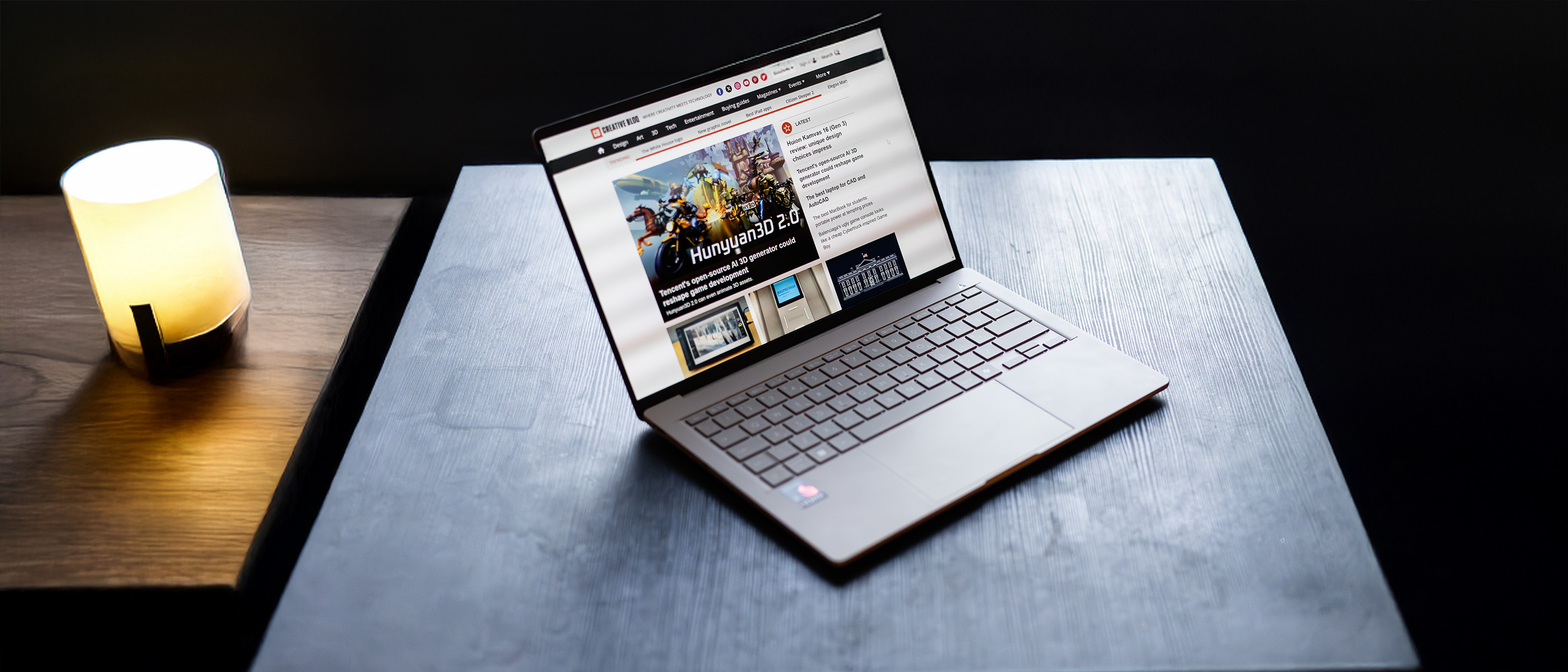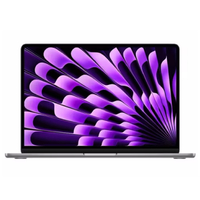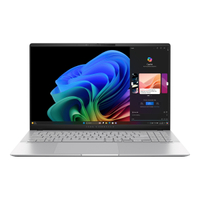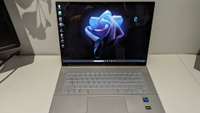Our Verdict
The allure of the thin and light laptop is that you can take it anywhere, and do anything. You know you’re going to pay a slight price in terms of processing power if you leave the gaming PC or MacBook Pro at home, but the tradeoff is usually worth it. The ASUS Zenbook A14 is so close to being a MacBook Air that it’s even possible to see the resemblance between the names A14 and Air, and most of the time it puts on an impressive showing, but there’s one thing that lets it down.
For
- Thin and light
- OLED screen
- Impressive CPU
Against
- Low GPU power
- Not cheap enough
Why you can trust Creative Bloq
The thin and light laptop has been a hotly contested sector of the market for years, and is the reason the MacBook Air exists. Apple’s 13.5in laptop has met its match (in lightness t erms, at least) in the Zenbook A14, however, as while the Air weighs 1.24kg, the A14 tips the scales at a mere 0.98kg. It’s ridiculously light, perfect for taking with you. You might never notice it’s in your bag if you’re in the habit of having a book or two in there.
And it impresses in other areas too, from the OLED screen to the Snapdragon X’s ability to keep up with Core and M series chips. Sadly, for anyone thinking of using it to push complex graphics around, the Adreno GPU is not up to the standards we’ve come to expect, even from integrated graphics, but if you can accept that 3D rendering is off the table, this is still a useful PC.
Key specifications
| CPU: | Snapdragon X X1 26 100 |
| NPU: | Qualcomm Hexagon |
| Graphics: | Qualcomm Adreno |
| Memory: | 16GB LPDDR5X |
| Storage: | 1TB PCIe 4.0 SSD |
| Screen size: | 14in |
| Screen type: | OLED |
| Resolution: | 1920 x 1200 |
| Refresh rate: | 60Hz |
| Colour gamut (measured): | 97% DCI-P3 |
| Brightness (measured): | 405 nits |
| Ports: | 1x USB 3.2 Gen 2 Type-A, 2x USB 4.0 Gen 3 Type-C, 1x HDMI 2.1, 1x 3.5mm audio |
| Wireless connectivity: | Wi-Fi 6E, Bluetooth 5.3 |
| Dimensions: | 31.07 x 21.39 x 1.59 cm |
| Weight: | 0.98kg |
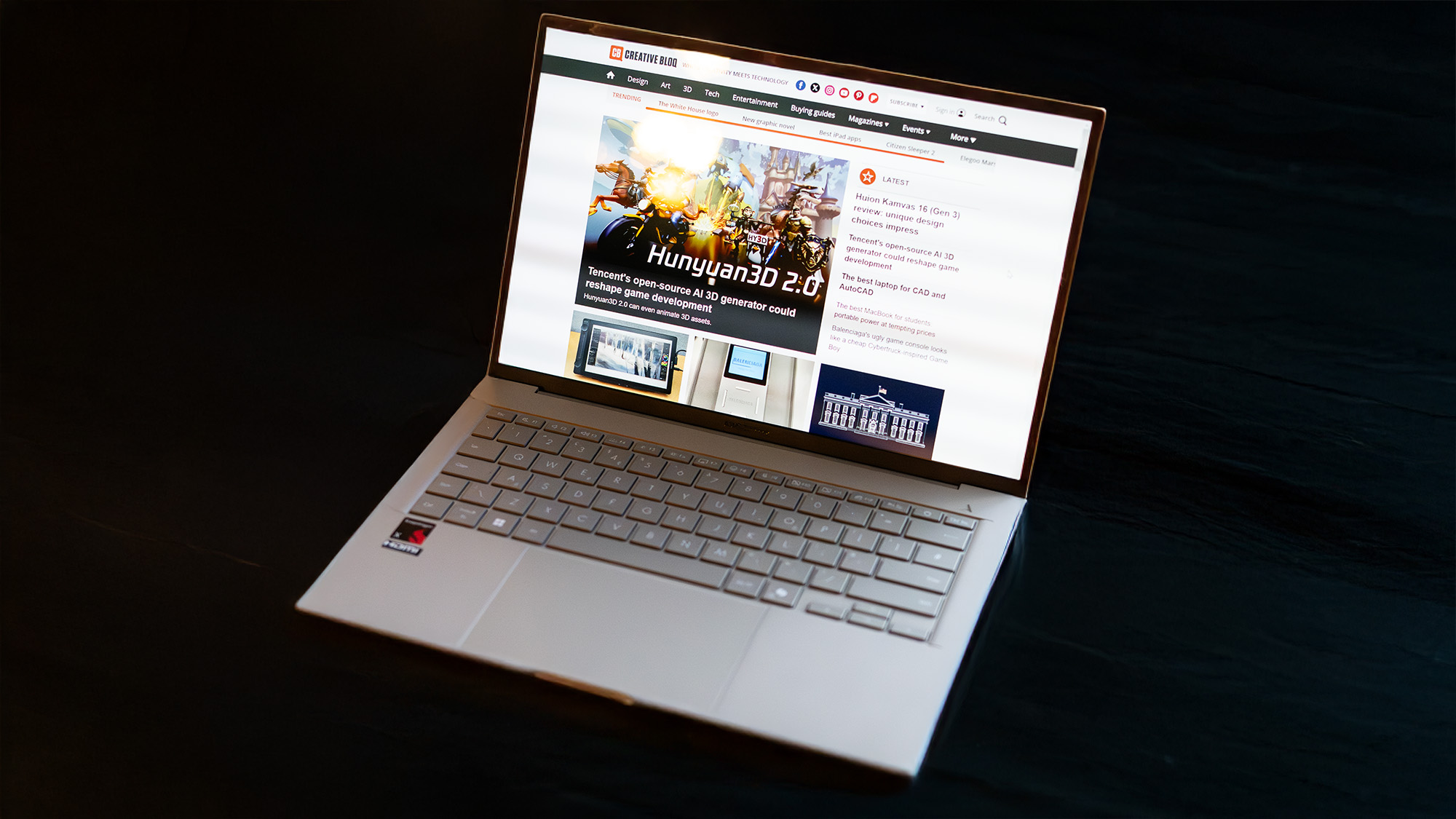
Design, build and display
• Thin and light
• Good port selection
• Bit plasticky
Asus has set out here to build the lightest 14in laptop it can, taking advantage of a new low-end Snapdragon chip to provide the core of the machine, then creating a plastic chassis around it. It’s been spectacularly successful at this - we can’t remember when we last saw a PC that came in at less than a kilogram - though it has resulted in a slightly unexciting and perhaps cheap-feeling build.
It’s not as plasticky as the Acer Vero 16, with its rough texture from its 60% recycled plastic shell, but the difference between the Asus Zenbook A14 and the Asus Vivobook S 15 with its aluminium casing is stark. Then again, Asus’ 15in Snapdragon laptop weighs almost half a kilo more than the A14, and the lack of weight is a big selling point here. Even the colours the A14 is available in are unobtrusive, with a light grey (as seen here) and a sandy beige rather than shiny silver or glossy black.
What you get for your 980g is a standard 14in laptop layout with a useful selection of ports. There's a full-size HDMI, so you don’t need to faff about with adapters or blocking a Type-C port when connecting to a projector, and a USB Type-A too, a 10Gbps one, for similar reasons. The two Type-C ports can be used for charging and are USB 4, which means they’re very fast and compatible with Thunderbolt 3, which will come in handy when hooking up to fast external storage or a camera. There's Wi-Fi 6E too, so you can get a fast network connection without needing to use an Ethernet adapter. It’s all very well thought out and convenient.
Design score: 4/5
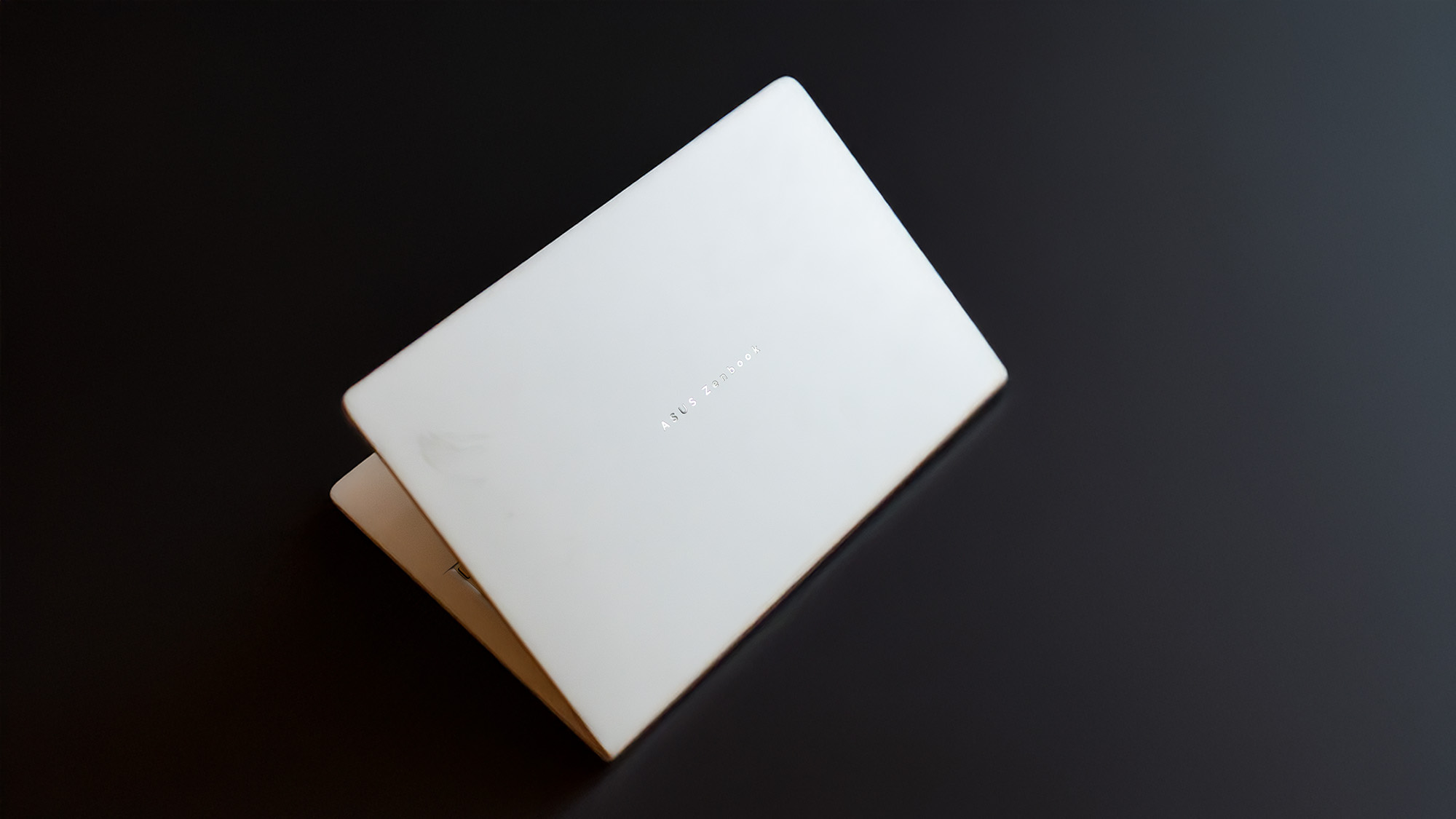
Features
• OLED screen
• Good colour response
• Can get sticky easily
The A14’s OLED screen isn’t spectacularly high-res, but does use the 16:10 aspect ratio that makes viewing documents easier than 16:9. You’ll get a good HD movie viewing experience from it too, though the built-in speakers are nothing special and you’ll be better off using Bluetooth cans or the 3.5mm jack. It’s still an OLED, however, so you’re going to get good brightness and colour saturation. In our tests it managed 100% of sRGB, 98% of Adobe RGB and 97% of DCI-P3, with a respectable maximum brightness level of 405 nits.
The keyboard and trackpad are well made, though the key travel is limited by the thinness of the machine. To go with the feeling of simplicity that the A14 brings, the backlight is a plain white one and the keys come without accoutrements such as dials and media keys. There's not even a fingerprint reader - the webcam offers Windows Hello face recognition - though there is a power button one key in from the far right, and the Copilot key is present as you’d expect from a Snapdragon machine.
The trackpad is again constrained by the size of the laptop, but we found it to be precise in use, though it has a distressing tendency to pick up an oily sheen from your fingers. Eaters of fried chicken for lunch may want to wash their hands extra thoroughly before getting back to work.
Feature score: 3/5

Benchmark scores
We test every one of our laptops using the same benchmarking software suite to give you a thorough overview of its suitability for creatives of all disciplines and levels. This includes:
• Geekbench: Tests the CPU for single-core and multi-core power, and the GPU for the system's potential for gaming, image processing, or video editing.
• Cinebench: Tests the CPU and GPU's ability to run Cinema 4D and Redshift.
• UL Procyon: Uses UL Solutions' Procyon software suite to test the system's ability for AI image generation in Stable Diffusion, its Microsoft Office performance and its battery life.
• Topaz Video AI: We use Topaz Video AI to test the system's ability to upscale video and convert video to slow-motion.
• PugetBench for Creators: We use the PugetBench for Creators benchmarking suite to test the system's ability to run several key tasks in Photoshop and DaVinci Resolve Studio, as well as its performance when encoding/transcoding video.
• ON1 Resize AI: Tests the system's ability to resize 5 photos to 200% in a batch process.
| GEEKBENCH 6 | Row 0 - Cell 1 | Row 0 - Cell 2 |
| CPU Single-core: | CPU Multi-core: | GPU OpenCL: |
| 2114 | 10607 | 9268 |
| CINEBENCH 2024 | Row 3 - Cell 1 | Row 3 - Cell 2 |
| CPU single-core: | CPU multi-core: | GPU: |
| 92 | 473 | GPU not compatible |
| UL PROCYON | Row 6 - Cell 1 | Row 6 - Cell 2 |
| AI Image Generation: | Office Productivity Benchmark: | Battery Life Benchmark: |
| Tests wouldn't run | Row 8 - Cell 1 | Row 8 - Cell 2 |
| TOPAZ VIDEO AI | Row 9 - Cell 1 | Row 9 - Cell 2 |
| Enhancement: | Slowmo: | Combined: |
| Test swouldn't run | Row 11 - Cell 1 | Row 11 - Cell 2 |
| PUGETBENCH for PHOTOSHOP | Row 12 - Cell 1 | ON1 RESIZE |
| General: | Filter: | 200% resize processing time: |
| Tests wouldn't run | Row 14 - Cell 1 | Row 14 - Cell 2 |
| PUGETBENCH for DAVINCI RESOLVE | Row 15 - Cell 1 | Row 15 - Cell 2 |
| General: | GPU Effects: | Row 16 - Cell 2 |
| Tests wouldn't run | Row 17 - Cell 1 | Row 17 - Cell 2 |
| Fusion score: | AI score: | H.264 encoding: |
| Row 19 - Cell 0 | Row 19 - Cell 1 | Row 19 - Cell 2 |
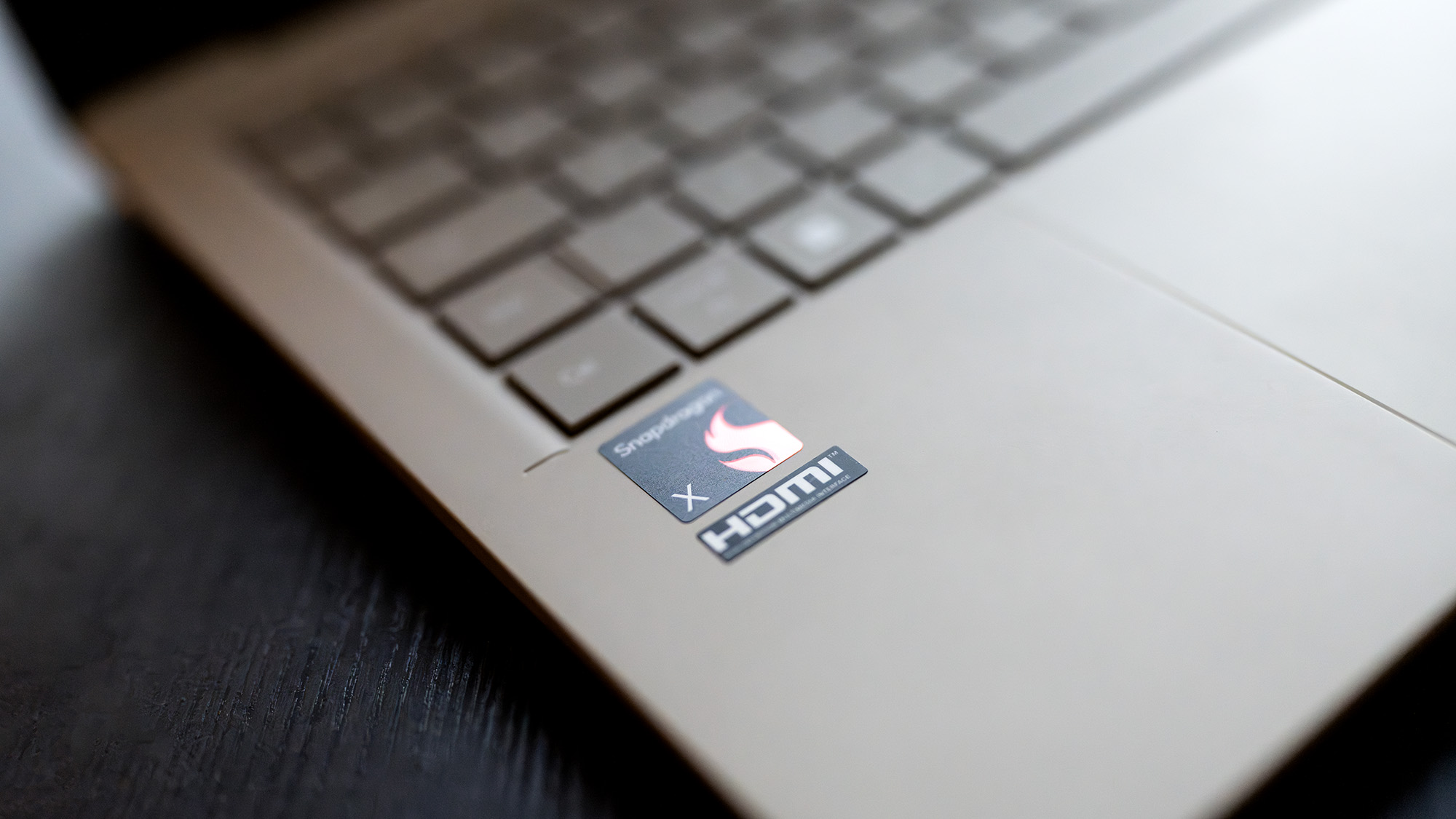
Performance
• Good CPU performance
• GPU lags behind
• Battery life excellent
This version of the Snapdragon X isn’t the Elite or even the Plus. The X1 drops the core count down to eight, with a matching reduction in power and price. Add to this the 16GB of RAM - the minimum for Copilot+ certification but starting to get a bit tight for creative work - and while it’s certainly not lacking in CPU power (its Geekbench results put it in the same ballpark as Apple’s M1 or M2, which are certainly not slow chips) it’s let down by its GPU.
In OpenCL Geekbench workloads Apple’s M1 scores twice as many points as the X1, and the Adreno GPU is incompatible with many of our other tests. This last point can be fixed with software updates, but the fact remains the Snapdragon’s integrated graphics chip isn’t pulling its weight when it comes to rendering anything more than web pages or presentations. Once we get Arm-based laptops with Nvidia or AMD graphics, or Adreno improves to Apple M-series standards, then we’ll be really talking.
One remarkable thing about the Zenbook A14 is ASUS’ claimed battery life. Somehow, the company thinks you’re going to get 32 hours of use out of something so slim and light that it’s hard to see where the extra battery cells have been stuffed. This claim comes from the efficiency of the Snapdragon chip, and the fact that it’s only using eight cores so will sip a little bit less power. In our testing, carried out over a weekend just in case ASUS’ prediction was accurate and it could go four eight-hour work days without needing to be recharged, it spluttered to a halt after 20h and 39m of constant video playback with the screen on. That's an excellent result, pointing to two days of use between charges.
Performance score: 4/5
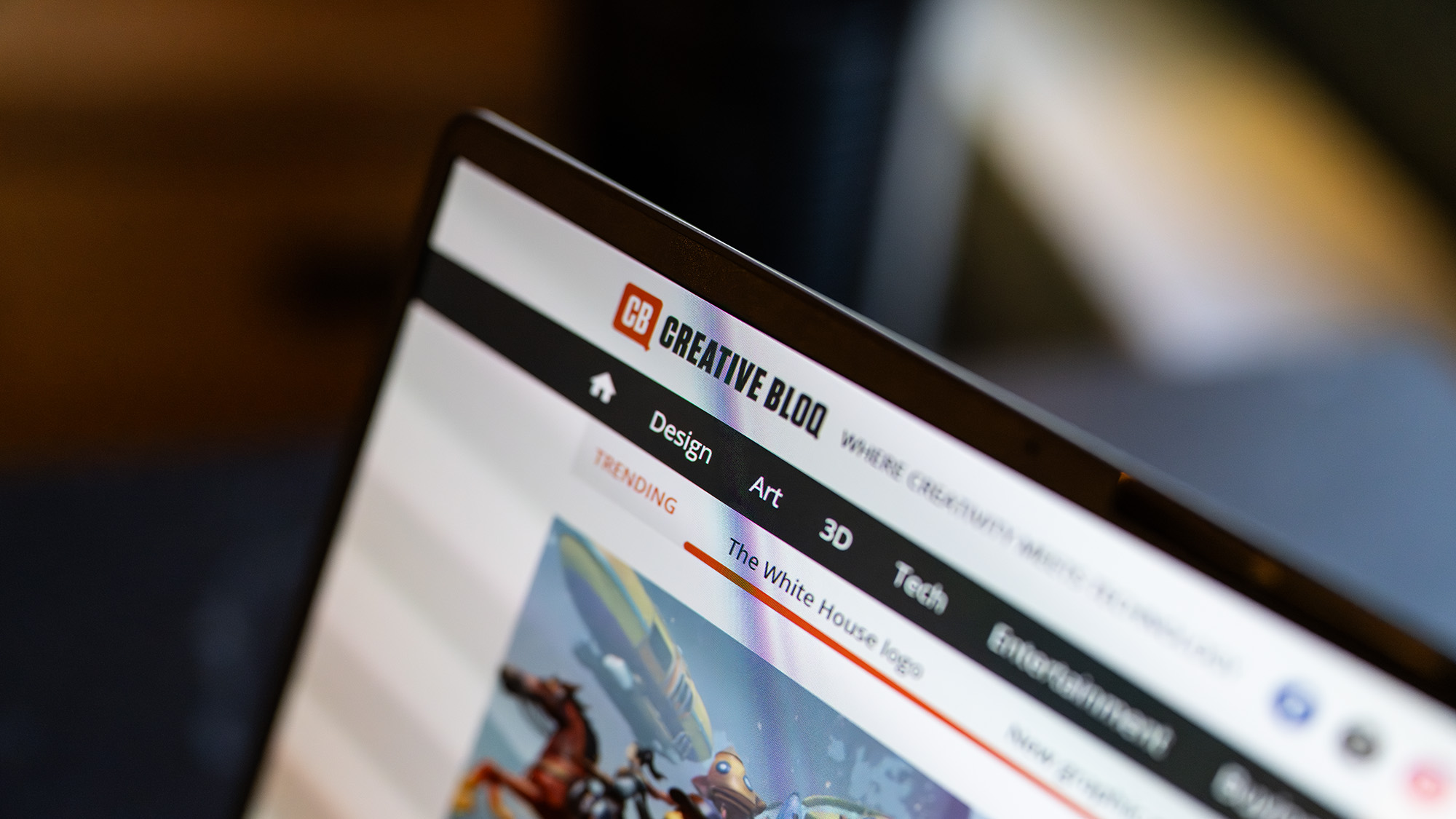
Price
The ASUS Zenbook A14 currently costs from £1,099.99 on ASUS' sales portal, which may be a problem for the A14. It’s the same price as the entry-level M3 MacBook Air 13in, which performs better, and if (when) a new M4 model comes out the gulf between them will widen. For now, the A14 has the benefit that it runs Windows, which has a wide appeal, and offers excellent battery life, but this isn’t going to be the only Air-adjacent PC to appear built around the Snapdragon X1, and it’s unlikely to be the cheapest.
Value score: 3/5
Who is it for?
This isn’t a laptop that’s being sold on the basis of its enormous processing power, but on its size, weight and convenience. In these categories, it’s a winner, and if you’re in the market for something that’s easily portable, doesn’t take up too much room, and can be easily tidied away but also has a bit of oomph and can connect to almost any peripherals then it’s a machine that could find its way into many studios and businesses, as well as being a convenient personal laptop for home workers.
| Attributes | Notes | Rating |
|---|---|---|
| Design: | Generic looks, but slim and very light | 4/5 |
| Features: | Good port selection | 3/5 |
| Performance: | CPU and battery very decent, but GPU lags behind | 4/5 |
| Value: | Plenty of competition at this price point | 3/5 |
Buy it if...
- You’re looking for a small, light laptop
- That has a good screen and connectivity
- But graphics performance doesn’t really matter
Don't buy it if...
- Your needs stretch to more graphics power
- You want a bigger screen
- You only want one machine for creative work
Also consider
The original thin and light laptop, the Air comes with a smaller SSD and a restrained port selection, but the incoming M4 model will beat the A14 for power.
Asus' other Snapdragon PC comes with an aluminium casing and a more powerful processor, but suffers from the same GPU deficiency.
This Core i5-powered 2-in-1 is cheaper than the A14, and a bit bigger too. It loses out in the battle of battery life, though.
out of 10
The allure of the thin and light laptop is that you can take it anywhere, and do anything. You know you’re going to pay a slight price in terms of processing power if you leave the gaming PC or MacBook Pro at home, but the tradeoff is usually worth it. The ASUS Zenbook A14 is so close to being a MacBook Air that it’s even possible to see the resemblance between the names A14 and Air, and most of the time it puts on an impressive showing, but there’s one thing that lets it down.

Ian Evenden has been a journalist for over 20 years, starting in the days of QuarkXpress 4 and Photoshop 5. He now mainly works in Creative Cloud and Google Docs, but can always find a use for a powerful laptop or two. When not sweating over page layout or photo editing, you can find him peering at the stars or growing vegetables.
You must confirm your public display name before commenting
Please logout and then login again, you will then be prompted to enter your display name.
